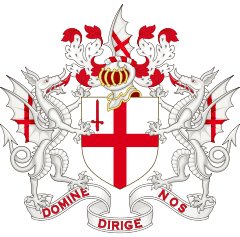Francis Child (died 1740)
Sir Francis Child the younger (c. 1684 – 1740), of the Marygold, by Temple Bar, and Osterley Park, Middlesex, was a British banker and politician who sat in the House of Commons from 1722 to 1740. He was Lord Mayor of London in 1731.
Early ife
Child was the son of Sir Francis Child. He was born probably in 1684, as the record of his admission to the freedom of the city of London is dated 12 March 1705. On the death of his elder brother Sir Robert Child in 1721, Child became the head of the banking firm, which was then carried on under the style of Francis Child & Co. He was also elected on 10 October in the same year to succeed his brother and father as alderman of the ward of Farringdon Without, and the following year he became Sheriff of London, with Alderman Humphrey Parsons as his colleague.
Career
In 1722, Child served the office of master of the Goldsmiths' Company, and was returned Member of Parliament for City of London at the 1722 general election. At the 1727 general election, he was elected one of the MPs for Middlesex, and was also returned at the succeeding general election of 1734.[1]
Child purchased in 1726 an estate at Northall for £19,501, which now forms part of the Osterley estate.[2]
From 1727 to 1740, he was president of Christ's Hospital, and his portrait is preserved in the board-room of that institution; another portrait, painted in his robes as lord mayor, is to be found at Osterley Park. In 1729 Child introduced a new form of promissory note, with a picture of Temple Bar in the left-hand corner. These were worded very similarly to the Bank of England notes of the present day, and were discontinued, as Mr. F. G. H. Price considers, before 1800. [2]
Child became Lord Mayor in 1731, and appointed as his chaplain Dr. John Middleton, rector of St. Peter's, Cornhill. Towards the close of his mayoralty, on 28 September in the following year, he attended with the court of aldermen, sheriffs, and other officials to congratulate George II on his safe return from Hanover. On this occasion the king conferred the honour of knighthood upon the lord mayor, Alderman John Barnard, and Alderman Henry Hankey, one of the sheriffs; addresses to the king and queen were read by Mr. Baron Thompson, the recorder, and their majesties returned gracious answers.
Child was elected a director of the East India Company in the year of his mayoralty, and was reelected in 1732.
Notes
- "CHILD, Francis (c.1684-1740), of the Marygold, by Temple Bar, and Osterley Pk., Mdx". History of Parliament Online. Retrieved 9 December 2018.
- Welch 1887.
References
![]()
| Parliament of Great Britain | ||
|---|---|---|
| Preceded by John Ward Sir Thomas Scawen Robert Heysham Peter Godfrey |
Member of Parliament for the City of London 1722–1727 With: Peter Godfrey 1722–1724 Sir John Barnard1722–1727 Richard Lockwood 1722–1727 Richard Hopkins 1724–1727 |
Succeeded by Sir John Eyles Micajah Perry Humphry Parsons Sir John Barnard |
| Preceded by Hon. James Bertie Sir John Austen, Bt. |
Member of Parliament for Middlesex 1727–1740 With: Hon. James Bertie 1727-1734 William Pulteney 1734-1740 |
Succeeded by William Pulteney Sir Hugh Smithson, Bt |
| Civic offices | ||
| Preceded by Humphrey Parsons |
 1731–1732 |
Succeeded by John Barber |